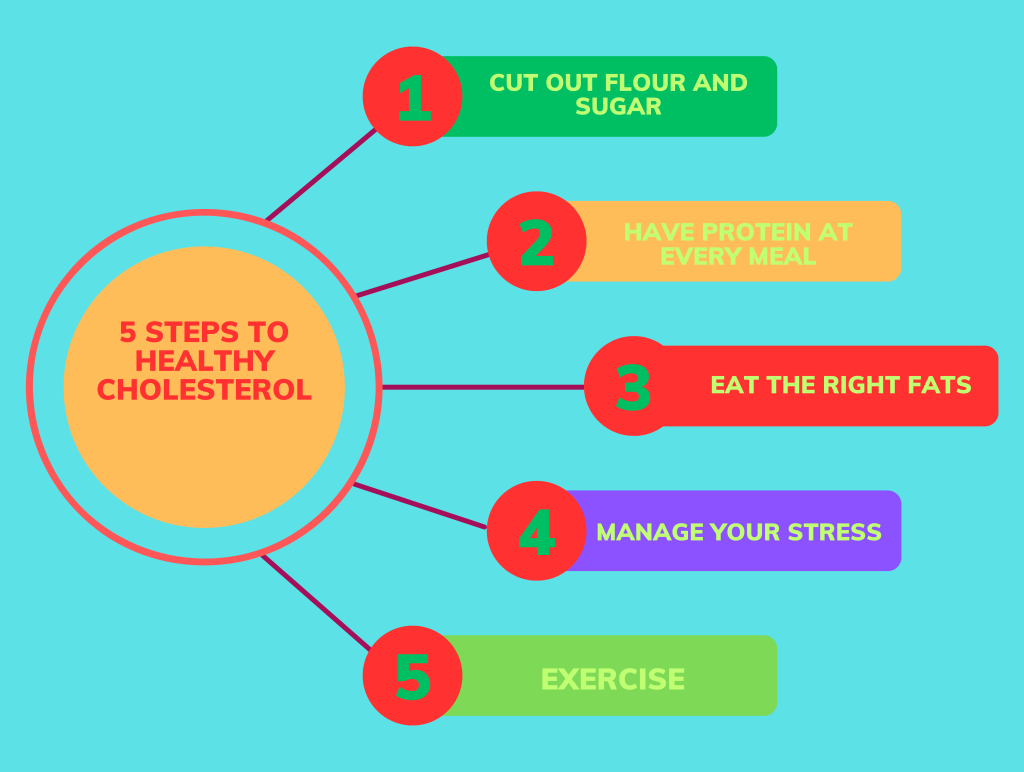Lipid
Impact of Avoiding Oil on Fat-Soluble Vitamins Absorption
Avoiding oil completely can hinder the absorption of fat-soluble vitamins in the body.
Effects on Blood Pressure from LDL Cholesterol and Triglyceride Levels
Increased levels of LDL cholesterol and triglycerides may lead to greater fluctuations in blood pressure.
Symptoms of High Bad Cholesterol
Persistently high levels of bad cholesterol can result in symptoms such as headaches, worsened by blood pressure fluctuations, as well as blurring of vision, dizziness, indigestion, constipation, and slurring of speech.
Cholesterol
Role and Production of Cholesterol
Cholesterol, a wax-like substance, is produced in the body and is present in all cells. The liver produces the majority of cholesterol (80%), while the remaining amount is obtained from food sources such as meat, poultry, and dairy products. Excess cholesterol in the bloodstream can lead to plaque formation on blood vessel walls, causing atherosclerosis and potentially resulting in heart attacks and stroke.
Functions of Cholesterol
Cholesterol serves multiple vital functions in the body including building and maintaining cell membranes, hormone production (estrogen, testosterone, adrenal hormones), bile acids production, vitamin D synthesis, and cortisol production.

Lipoproteins Composition and Measurement
Lipoproteins, comprising cholesterol, triglycerides, apolipoproteins, and phospholipids, include HDL (high-density lipoprotein) and LDL (low-density lipoprotein). Triglyceride levels are calculated by dividing the triglyceride value by 5, while the cholesterol ratio is determined by dividing the total cholesterol value by the HDL cholesterol value. Specific cholesterol ranges indicate heart health risks.
Risk Factors Associated with Cholesterol Levels
Various factors influence cholesterol levels including age, smoking, lack of physical activity, obesity, family history, unhealthy diet, alcohol consumption, diabetes, and familial hypercholesterolemia.
HDL and LDL Cholesterol
Importance of HDL Cholesterol
HDL cholesterol, known as “good” cholesterol, aids in reverse transport, removing LDL cholesterol and transporting it to the liver. It possesses anti-inflammatory properties and higher levels are beneficial for heart and blood vessel health.
Life Cycle of Cholesterol
Cholesterol is produced in the liver, circulates in the bloodstream, removes LDL cholesterol, and is excreted in bile.
Role of LDL Cholesterol
LDL cholesterol, termed “bad” cholesterol, when elevated, contributes to plaque formation on blood vessel walls, narrowing them and obstructing blood flow, thus increasing the risk of heart attacks and stroke.
Triglycerides
Triglycerides, another form of cholesterol, are stored energy molecules. Elevated levels increase the risk of heart disease and metabolic syndrome.
| Total Cholesterol | LDL | HDL | Triglycerides | |
| Heart Healthy | < 200 | < 100 | 60 and above | < 200 |
| At Risk | 200 – 239 | 100 – 159 | 40 – 59 – Male 50 – 59 – Female | 200 – 399 |
| Dangerous | 240 and above | 160 and above | < 40 – Male < 50 – Female | 400 and above |
Dietary Strategies for Cholesterol Management
Vegetables and Fruits
Certain vegetables and fruits like brinjal, garlic, onion, kidney beans, cabbage, cauliflower, broccoli, tomato, carrot, greens, and ginger can help lower LDL cholesterol and increase HDL cholesterol levels. Brinjal – High in fiber and low in calories. A 100g serving of brinjal contains 30g of fiber.
Ladies Finger (Okra) – High in fiber and low in calories.
Garlic – Allicin, a substance in garlic, helps lower triglycerides.
Onion – Onion is rich in the antioxidant Quercetin.
Kidney Beans – Kidney beans contain higher levels of lectin, proteins, and fibers, making them beneficial for cholesterol management.
Greens – Green Malabar spinach is considered the best among greens due to its high content of antioxidant lutein.
Fruits
Fruits such as apples, grapes, oranges, lemon, guava, banana, pomegranate, pear, watermelon, and avocado contain compounds that aid in cholesterol regulation.
Apple
Description: Apples contain polyphenols and pectin.
Effect on Cholesterol: The pectin in apples increases beneficial bacteria in the large intestine and helps prevent LDL levels from increasing.
Orange
Lemon
Effect on Cholesterol: Lemon and orange both contain pectin and citric acid, which help lower cholesterol levels.
Butter Fruit (Avocado)
Description: Avocado, also known as butter fruit, is rich in Vitamin E.
Effect on Cholesterol: The monounsaturated fats in avocado raise HDL levels and lower LDL levels.Nuts, Seeds, and Grains
Almonds, walnuts, oats, seeds (pumpkin, chia, fenugreek, coriander), chickpeas, pulses, millets, turmeric, green tea, soy foods, berries, and barley are beneficial in managing cholesterol levels.
Almonds and Walnuts
Description: Rich in monounsaturated fats, soluble fibers, and flavonoids.
Effect on Cholesterol: Raises HDL cholesterol and lowers LDL cholesterol.
Oats – Rich in beta-glucan and soluble fibers.
Seeds (Pumpkin, Chia, Fenugreek, Coriander)
Effect on Cholesterol: The sterol and stanol in pumpkin seeds lower cholesterol levels.
Pulses and Millets – Finger millet and foxtail millet are high in soluble fiber.
Turmeric
Effect on Cholesterol: Lowers LDL cholesterol levels.
Green Tea
Description: Contains an antioxidant called catechin.
Soy Foods – Contains isoflavonoid proteins.
Berries (Strawberry, Blueberry, Raspberry)
Effect on Cholesterol: High in polyphenols.
Barley – Rich in soluble fibers.
Fish
Effect on Cholesterol: Increases HDL cholesterol. Kingfish and sardine fish are recommended.
